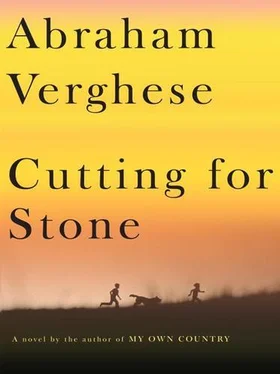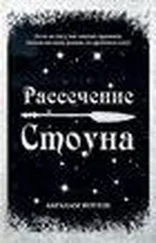“Whatever happens, Marion, you mustn't let Hema know. I had my slides sent off about two years ago through Eli Harris to Dr. Maxwell Wintrobe in Salt Lake City Utah, USA. He's a fabulous hematolo-gist. I love his textbook. He personally wrote me back. What I have is like an active volcano, rumbling and spitting. Not quite a leukemia, but brewing into one; it's called ‘myeloid metaplasia,’ “ he said, pronouncing it carefully as if it were something delicate and exquisitely wrought. “Remember the term, Marion. It's an interesting disease. I still have many years left, I'm sure. The only troublesome symptom I have now is anemia. These blood transfusions are my oil changes. I'm going dancing tonight with Hema. It's our big day, you know. I wanted more gumption.”
“Why won't you let Ma know? Why didn't you let me know?”
Ghosh shook his head. “Hema will go crazy … She'll, she shouldn't, she can't … Don't look at me that way, my son, I'm not being noble, I promise you.”
“Then I don't understand.”
“You didn't know about my diagnosis these last two years, did you? If you had known, it would've changed your relationship with me. Don't you think?” He grinned, and he ruffled my hair. “You know what's given me the greatest pleasure in my life? It's been our bungalow, the normalcy of it, the ordinariness of my waking, Almaz rattling in the kitchen, my work. My classes, my rounds with the senior students. Seeing you and Shiva at dinner, then going to sleep with my wife.” He stopped there, silent for a long time as he thought of Hema. “I want my days to be that way. I don't want everyone to stop being normal. You know what I mean? To have all that ruined.” He smiled. “When things get more severe, if it ever comes to that, I'll tell your ma. I promise.”
He looked at me intently. “You'll keep this a secret? Please? It's what you can do for me. A gift, if you like. Give me as many normal days as I can possibly have. And you mustn't tell your brother either. That might be hardest for you. I know you two have had a … rift. But you understand Shiva better than anyone. I know you care enough for him to protect him from this news getting to him prematurely.”
I gave him my word.

ABOUT THE NEXT FEW MONTHS, I remember very little, except that Ghosh's wisdom was revealed. It had been a blessing not to know for the last two years. Now that I knew, there was no turning back time or erasing that knowledge; it was as if he were back in jail again and, in a way, so was I. I read everything I could about myeloid metaplasia (how I hated that term which he loved). His bone marrow was quiet when I first learned of his diagnosis. But then the disease became more active, the volcano started rumbling, oozing lava, spitting telltale traces of sulfurous gas when the wind was right.
I spent as much time as I could with Ghosh. I wanted every bit of wisdom he could impart to me. All sons should write down every word of what their fathers have to say to them. I tried. Why did it take an illness for me to recognize the value of time with him? It seems we humans never learn. And so we relearn the lesson every generation and then want to write epistles. We proselytize to our friends and shake them by the shoulders and tell them, “Seize the day! What matters is this moment!” Most of us can't go back and make restitution. We can't do a thing about our should haves and our could haves. But a few lucky men like Ghosh never have such worries; there was no restitution he needed to make, no moment he failed to seize.
Now and then Ghosh would grin and wink at me across the room. He was teaching me how to die, just as he'd taught me how to live.
SHIVA AND HEMA went about their days ignorant of Ghosh's condition. They were caught up in their own excitement. Shiva had coaxed Hema into a major commitment to treating women with vesiculovaginal fistula, or “fistula” for short. It wasn't a condition that Hema (or any gynecologic surgeon) relished seeing because it was difficult to cure.
Now I can explain why that little girl whom we'd seen when we were young children—the one who came walking up the hill with her father, her head bowed with shame, dribbling urine at every step, carrying about her an unspeakable odor—had such a profound influence on Shiva's life.
Unbeknownst to Shiva and me, Hema had operated on her three times. The repair broke down the first two times; the last one held. We never got to see her leave Missing, but we had Hema's word that she was cured and had left happy. The mental scars, though, would never heal. We understood little at the time of what ailed her; it wasn't a subject Hema would speak about to us. But now, Shiva and I knew. In all likelihood, perhaps before she was a teen, the girl was married off to a man who could have been as old as her father. The painful consummation of her marriage (more traumatic if circumcision had left scar tissue at the entrance to the vagina for the husband to batter down) would have terrifed her. She may even have been too young to connect this act with becoming pregnant, but soon she was swollen with child. When labor began, the baby's head jammed against her pelvic bones, the pelvic inlet already narrowed by rickets. In a developed country or a big city she might have had a Cesarean section as soon as her contractions started. But in a remote village, without the help of anyone but her mother-in-law, she would suffer for days, her uterus trying to do the impossible, but succeeding only in ramming the baby's head against the bladder and the cervix, crushing those tissues against the unyielding bony pelvis. The baby soon died inside the womb and the mother's death would follow shortly, most often due to a ruptured uterus or infection and septicemia. It was the rare family who managed to transport the mother to a health center. There the lifeless fetus could be removed piecemeal, by first crushing the skull and then pulling the rest out.
During her convalescence from that dreadful labor, the dead and gangrenous tissues inside her birth passage eventually sloughed off, leaving her with a jagged hole between bladder and vagina. Instead of urine passing from bladder to urethra to emerge just under the clitoris (and only when she chose to void), the bladder now constantly leaked its contents directly into the vagina and down her legs. She was never dry, her clothes always soaked, and she dribbled all day. The bladder and its urine quickly became infected and foul-smelling. In no time her labia, her thighs, became wet and macerated and oozed pus. This must have been when her husband cast her off, and her father came to the rescue.
Fistulas have been described since antiquity. But it wasn't till 1849 in Montgomery, Alabama, that Dr. Marion Sims, my namesake, first succeeded in repairing a vaginal fistula. His first patients were Anarcha, Betsy, and Lucy, three slave women who had been cast out by their families and their owners because of this condition. Sims operated on them—willing subjects we are told—in an attempt to cure the fistula. Ether had just been discovered but wasn't in widespread use, so his patients were wide awake. Sims closed the gaping hole between bladder and vagina with silk and thought he had cured them. But a week later, he found pinhole openings along the line of his repair through which urine was leaking. He kept trying. He operated on Anarcha some thirty times. He learned from each failure, modified his technique until he ultimately got it right.
When Hema operated on the girl wed seen, she used the principles of repair established by Marion Sims. She first put a catheter through the urethra into the bladder to divert the urine away from the fistula to allow the wet, macerated tissues to dry and heal. A week later, Hema operated vaginally using the bent pewter spoon the Alabama surgeon had fashioned—the Sims speculum, we now call it—which allowed for good exposure and made vaginal surgery possible. She had to carefully dissect out the edges of the fistula, trying to find what had once been discrete layers of bladder lining, bladder wall, then vaginal wall and vaginal lining. Once she had trimmed the edges, she made her repair, layer by layer. Sims, after many failures, had a jeweler fashion a thin silver wire which he used to close the surgical wound. Silver elicited the least inflammatory reaction from the tissues, inflammation being the reason a repair would break down. Hema used chromic catgut.
Читать дальше













